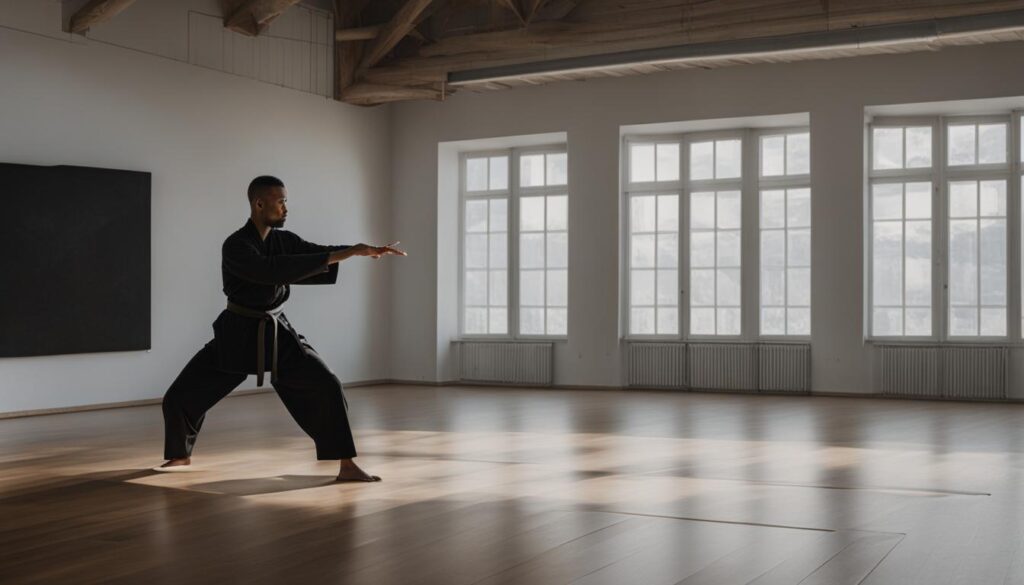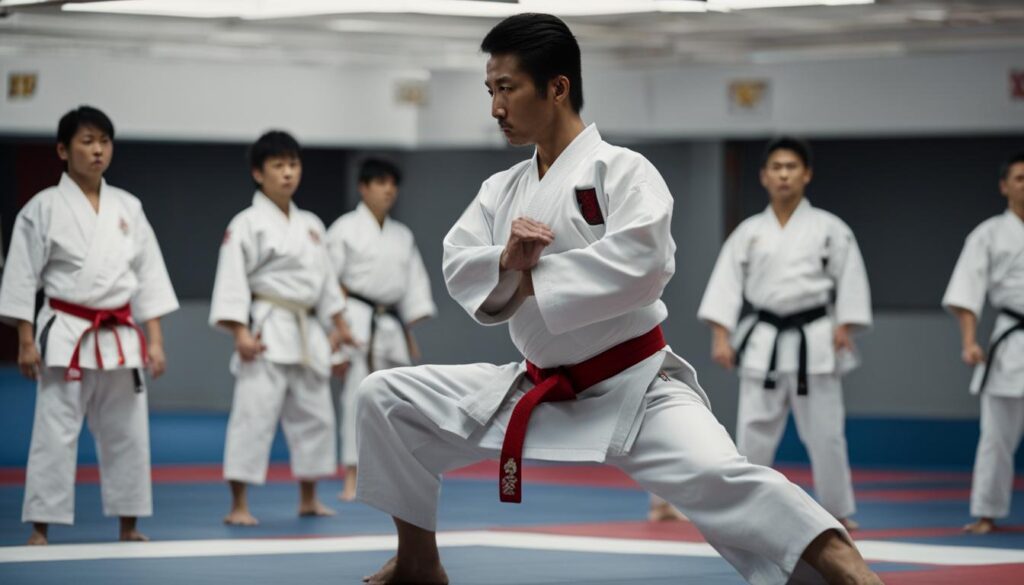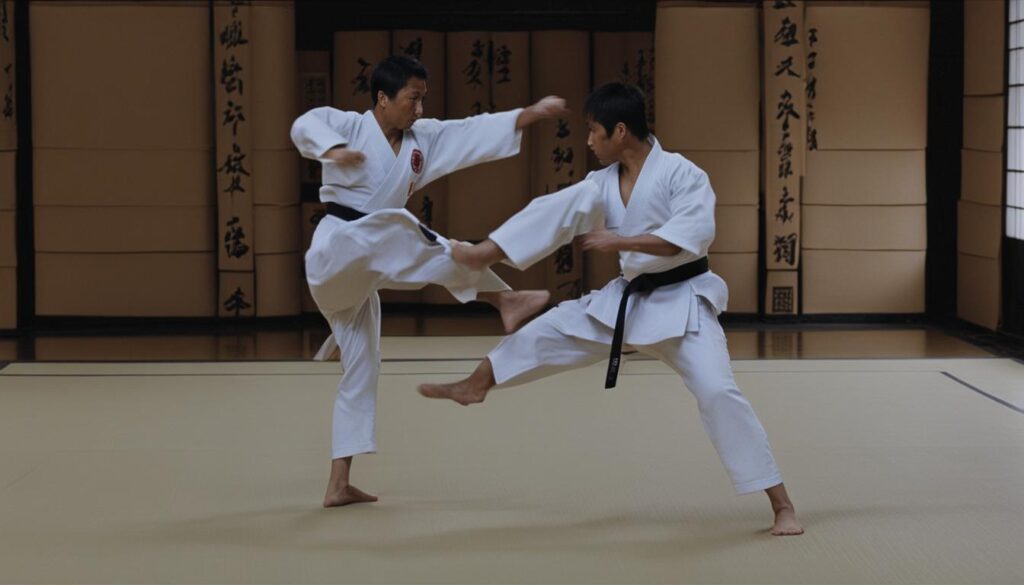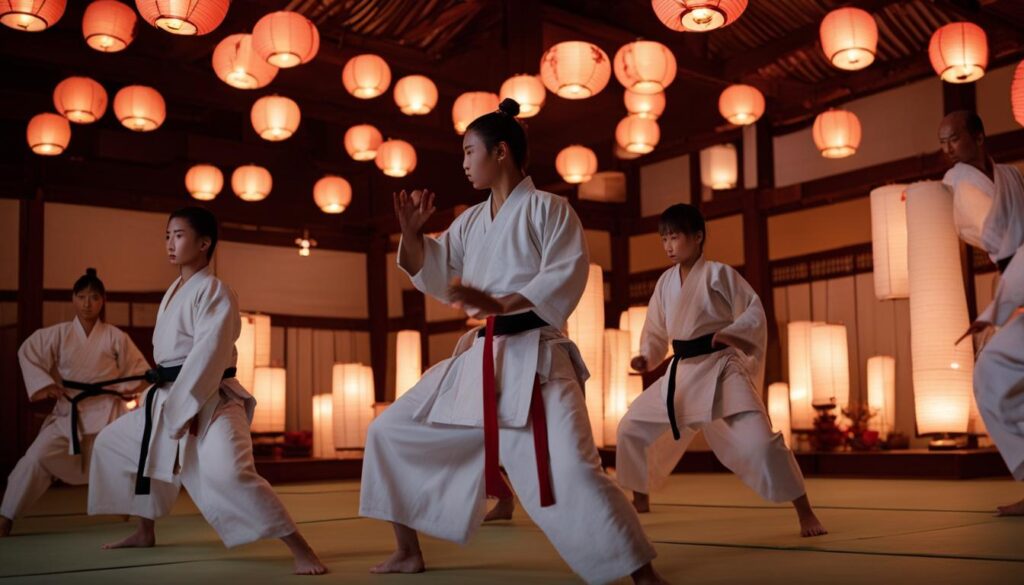Welcome to our in-depth exploration of karate! In this article, we’ll be taking a closer look at one of the core elements of karate training: kata. Whether you’re a beginner or a seasoned karate practitioner, understanding the significance of kata is crucial to your martial arts journey.
Kata, meaning “form” in Japanese, is a series of choreographed movements and techniques that are essential to karate. It serves as a mnemonic tool, allowing practitioners to store and transmit a wide range of combat movements and concepts. From stances and footwork to punches, kicks, blocks, holds, and throws, kata encompasses the fundamental principles and techniques of karate.
In this article, we’ll delve into the history and origins of kata, its importance in karate training, and how to perform and improve your kata skills. We’ll also explore the application of kata in practical self-defense scenarios through the concept of bunkai. Lastly, we’ll touch on the significance of kata training in modern karate and its recent inclusion in the Olympic Games.
Key Takeaways:
- Kata is a series of highly practical combat movements and techniques in karate.
- It originated from China and became a fundamental aspect of karate in Okinawa.
- Kata training helps develop body mechanics, muscle memory, and mindfulness.
- Proper execution of kata requires attention to detail, precision, and correct technique.
- Bunkai is the application of kata movements in practical self-defense situations.
The Origin and History of Kata in Karate
Karate, originally from Okinawa, an island chain between China and Japan, has a rich history deeply influenced by Chinese martial arts. Specifically, the practice of kata in karate can be traced back to the influence of Fujian Kung-Fu, which was introduced to Okinawa by Chinese settlers. The Ryukyu Kingdom, as Okinawa was known at the time, had a cultural exchange with China, leading to the incorporation of Chinese fighting methods into the native Ryukyuan empty-handed fighting system.
Kata training, an integral part of karate, was primarily practiced by the aristocratic class called Yukatchu. Over time, kata was refined through interactions with Chinese masters and Okinawan practitioners studying martial arts in China. This exchange and development shaped the distinct kata training in Okinawan karate, setting it apart from other martial arts disciplines.
What is Kata in Karate?
Kata, which means “form” in Japanese, is a series of highly practical combat movements and techniques that are meticulously choreographed. It serves as a mnemonic tool to store and transmit various series of combat movements and concepts. Kata encompasses fundamental principles and concepts of karate, including stances, footwork, punches, kicks, blocks, holds, and throws. There are numerous types of kata practiced in karate, each with its own specific sequences and techniques.

In karate, the practice of kata is an essential element that allows practitioners to refine their skills, develop muscle memory, and gain a deeper understanding of the art form. Each kata is like a living textbook, preserving the traditional techniques, principles, and teachings of karate. By learning and performing different types of kata, karateka can enhance their martial arts techniques and embody the essence of the art.
The Importance of Kata in Karate
Kata plays a crucial role in karate training, offering numerous benefits that contribute to an individual’s growth as a martial artist. By incorporating kata into their practice, karateka can enhance their overall skillset and deepen their understanding of the art. Let’s explore the importance and advantages of practicing karate kata.
Develop Proper Body Mechanics
Practicing karate kata helps develop proper body mechanics, ensuring that every movement is executed with precision and efficiency. By consistently performing the prescribed techniques, karateka learn to align their body, improve posture, and achieve optimal balance and coordination.
Build Muscle Memory
Repeating the sequences in karate kata strengthens muscle memory, allowing karateka to perform techniques instinctively and without hesitation. This subconscious recall enables practitioners to execute moves swiftly and accurately, even in high-pressure situations.
Cultivate Mindfulness
Kata practice fosters mindfulness, promoting a deep sense of focus and concentration. As karateka engage in the rhythmic flow of movements, they develop mental clarity and learn to be present in the moment, enhancing their overall awareness both in and out of the dojo.
Enhance Breathing Techniques
Breathing is an essential aspect of karate, enabling karateka to generate power and maintain control during their techniques. Through the performance of kata, practitioners hone their breathing techniques, synchronizing breath and movement to optimize their performance and amplify their strikes.
Refine Technique and Acquire Understanding
Regular practice of karate kata enables practitioners to refine their technique, ensuring that every punch, kick, and block is executed with precision. The detailed choreography of kata allows individuals to explore the underlying principles and concepts of karate, deepening their understanding of the art.
Preserve and Pass on Tradition
Kata serves as a vessel for preserving and passing on the traditional techniques and styles of karate from one generation to the next. By dedicating themselves to the study of kata, practitioners ensure that the art’s rich history and heritage continue to thrive.
In conclusion, kata holds immense importance in karate, offering a multitude of benefits that contribute to a practitioner’s growth and development. From cultivating proper body mechanics and muscle memory to promoting mindfulness and enhancing breathing techniques, kata plays a vital role in building a strong foundation in karate. It is through the consistent practice of kata that karateka refine their technique, develop power, improve balance and coordination, and acquire a deep understanding of the principles underlying the art.
How to Perform Karate Kata Properly
Performing karate kata requires dedicated practice and repetition. It takes years to master a kata fully. The practitioner must follow the specific techniques, stances, and movements prescribed by the kata. Attention to detail, precision, and correct execution of each technique is crucial. Proper breathing is also emphasized during kata performance, as it enhances focus and concentration. Regular practice and guidance from a qualified instructor are essential for understanding and executing kata properly.
Here are some key steps to perform karate kata properly:
- Learn the Kata: Start by learning the sequence of movements and techniques in the kata you are practicing. Familiarize yourself with the stances, strikes, kicks, blocks, and transitions between movements.
- Focus on Form: Pay attention to your posture and body alignment throughout the kata. Maintain proper stances, keep your back straight, and execute each technique with precision.
- Practice Slowly: Begin by practicing the kata at a slow pace, focusing on the correct execution of each movement. This allows you to develop muscle memory and improve your technique.
- Gradually Increase Speed: Once you are comfortable with the kata at a slow pace, gradually increase the speed while maintaining accuracy and control. This helps develop fluidity and timing in your movements.
- Breathe Properly: Pay attention to your breathing during the kata. Inhale deeply through your nose and exhale forcefully through your mouth in sync with your movements. This promotes relaxation and focus.
- Visualize Your Opponent: Imagine an opponent in front of you while performing the kata. Visualize the strikes, blocks, and evasive movements as if you are engaged in combat. This adds a realistic aspect to your performance.
- Practice with Intent: Approach each practice session with focus and intent. Treat each repetition of the kata as a meaningful practice towards improvement. Maintain a clear mind and strive for perfection in each technique.
- Seek Feedback: Receive feedback from your instructor or more advanced practitioners. They can provide valuable insights and corrections to help you refine your technique and performance.
Remember, mastering karate kata requires patience, dedication, and consistent practice. By following these steps and continuously striving for improvement, you can progress in your karate journey and unlock the full potential of kata.

Tips to Improve Karate Kata
Here are some tips to enhance your karate kata performance:
- Practice regularly: Consistent practice is key to improving your kata skills. Dedicate regular time to hone your techniques and memorize the sequences.
- Focus on technique: Pay attention to each movement and strive for precision. Every stance, punch, and kick should be executed with proper form and control.
- Engage your mind: Kata is not just a physical exercise; it requires mental concentration and focus. Stay present in the moment and visualize each technique as if you were in a real fight.
- Seek feedback: Receive guidance and feedback from your instructor to help refine your technique. They can provide valuable insights and corrections to improve your performance.
- Visualize opponents: Imagine an opponent while performing kata to enhance the realistic aspect. This helps you visualize the practical application of each movement and improves your spatial awareness.
- Slow down: Slow, deliberate movements allow for better understanding and control of techniques. Focus on executing each movement correctly and gradually increase speed as you gain mastery.
- Record and analyze: Recording your kata performances and analyzing them can help identify areas for improvement. Pay attention to your timing, rhythm, and transitions, and make necessary adjustments to enhance your overall performance.
By incorporating these tips into your training routine, you can elevate your karate kata skills and become a more proficient and disciplined karateka.
Bunkai – The Essence of Kata
Bunkai is a vital aspect of karate practice that focuses on the application and interpretation of kata movements in practical self-defense situations. It involves extracting the techniques and principles embedded within the kata and applying them in real-world scenarios. Through bunkai, karateka delve deeper into the meaning and effectiveness of each movement in the context of combat.
Bunkai provides a bridge between the choreographed movements of kata and their practical applications. It allows practitioners to translate the sequences of kata into effective techniques that can be utilized in self-defense situations. By analyzing the movements, angles, and timing, karateka gain a deeper understanding of the functional aspects of kata and how they can be applied in real-life encounters.
Through the practice of bunkai, students learn to recognize and exploit the vulnerabilities of an opponent, incorporating strikes, joint locks, takedowns, and submissions within the context of the kata. By studying bunkai, karateka develop a more comprehensive understanding of the underlying principles and concepts of karate.
Implementing bunkai in training sessions enables practitioners to train with a partner, fostering realistic combat scenarios and honing their self-defense skills. By applying the techniques learned through bunkai, karateka develop muscle memory, timing, and proficiency in executing practical techniques. Bunkai serves as a bridge between kata and practical self-defense, fostering a deeper connection to the martial art and its ability to be applied in real-life situations.

Bunkai is an essential component of karate training, as it not only enhances self-defense skills but also provides valuable insights into the movements and techniques of kata. By practicing bunkai, karateka gain a deeper understanding and appreciation for the art of karate, unlocking the practical applications of kata and further refining their overall martial arts abilities.
Karate Kata: A Journey Through Time
Karate kata has a rich history that reflects the diverse historical and cultural influences on the art. From its inception, karate kata has evolved through various events and interactions, incorporating techniques from Chinese martial arts and Okinawan fighting styles. These influences have shaped the movements and techniques found in karate kata today. Practitioners of karate now engage in a wide range of kata, each with its own unique set of movements and techniques.
| Period | Key Developments |
|---|---|
| Chinese Influence | The early practice of kata in Okinawa was heavily influenced by Chinese martial arts, particularly Fujian Kung-Fu. Chinese settlers introduced these martial arts to Okinawa, resulting in a fusion of Chinese techniques with native Okinawan fighting styles. |
| Okinawan Innovations | Okinawan practitioners further refined the kata through interactions with Chinese masters and their own experimentation. The native fighting methods of the Ryukyu Kingdom merged with Chinese techniques, leading to the development of unique kata sequences and styles. |
| Modern Evolution | In modern times, karate kata continues to evolve as practitioners explore new interpretations and adapt to changing training methodologies. Contemporary styles of karate have developed their own kata with innovative movements and techniques. |
The study of karate kata is a fascinating journey through time, as practitioners delve into the traditions and innovations that have influenced the art. Each kata carries the legacy of countless generations of karateka, preserving the essence of the martial art within its movements and principles.

The Significance of Kata Training in Modern Karate
Despite the evolution of martial arts and the introduction of other training methods, kata training remains an essential component of modern karate. It serves as a foundation for skill development, instilling discipline, focus, and perseverance in practitioners.
Kata training offers numerous benefits for karateka, both physically and mentally. Through the practice of kata, individuals enhance their physical conditioning, developing strength, flexibility, and endurance. The precise movements and techniques involved in kata sharpen technique and improve body mechanics, leading to greater overall proficiency in karate. Furthermore, kata training promotes mental clarity and concentration, fostering mindfulness and focus.
Moreover, kata provides a platform for continuous growth and advancement. As practitioners progress through different kata levels, they continually refine their skills, mastering more complex movements and sequences. This constant challenge keeps the training journey engaging and rewarding.
Kata training is not limited to traditional settings; it encompasses both the traditional aspects of karate and modern competitive practices. In traditional karate, kata is often performed individually as a means of self-improvement and preserving the essence of the art. In competitive karate, kata competitions showcase the skill, precision, and artistry of karateka as they perform choreographed sequences with technical proficiency and athletic flair.
Overall, kata training holds immense significance in modern karate, embodying the rich heritage and tradition of the martial art. It ensures the passing down of essential techniques and principles from generation to generation, keeping karate alive and thriving.
| Physical Benefits | Mental Benefits |
|---|---|
|
|
Karate Kata in the Olympic Games
Karate kata made its long-awaited debut in the Olympic Games at Tokyo 2020. It was included as a medal event alongside kumite. Participants performed kata routines that were judged based on technical proficiency and athletic display. The inclusion of karate kata in the Olympics is a recognition of its cultural significance and the skill and artistry involved in its execution.
As karate kata took the center stage at the Olympics, athletes from around the world showcased their expertise and mastery of this traditional martial art form. The rigorous training and dedication required to excel in kata were evident in the precision and fluidity displayed by the competitors.
Judges assessed the athletes’ performances based on various criteria, such as technique, power, timing, rhythm, and expression. Each kata routine showcased a unique combination of explosive moves, intricate footwork, and precise strikes, highlighting the complexity and beauty of the art.
The inclusion of karate kata in the Olympics not only elevates the status of this ancient martial art but also provides a platform for its practitioners to demonstrate their skills on a global scale. It allows audiences worldwide to appreciate the discipline, grace, and intensity of karate kata as a competitive sport.
Olympic Karate Kata Medals
| Event | Gold | Silver | Bronze |
|---|---|---|---|
| Male Individual Kata | Toshihito Kakui (Japan) | Spaniard Athlete (Spain) | Third Place Athlete (Country) |
| Female Individual Kata | Ayumi Uekusa (Japan) | Spanish Athlete (Spain) | Third Place Athlete (Country) |
| Team Kata | Japanese Team | Spanish Team | Third Place Team |
The top karateka displayed extraordinary skill and passion, with Japan showcasing their dominance in the kata events. The performances brought together tradition, athleticism, and artistry, captivating audiences worldwide and cementing karate kata as an integral part of the Olympic Games.
Conclusion
Kata is an integral part of karate training, embodying the essence of this martial art. With a rich history and various types, kata serves as a repository of principles and techniques. Mastering kata requires dedication and consistent practice, as it offers numerous benefits for both physical and mental development. By engaging in kata practice, karateka enhance their physical attributes, cultivate discipline, and gain a deeper understanding of the art.
Moreover, the inclusion of karate kata in the Olympic Games showcases its prestige and cultural significance. As karateka perform kata routines with technical proficiency and artistic expression, they exemplify the skill and artistry inherent in this traditional aspect of karate. The recognition received through its inclusion in the Olympics further solidifies karate kata as a revered and cherished element of the martial art.
In conclusion, kata is not merely a series of choreographed movements, but a pathway to self-improvement and mastery. Through dedicated practice and unwavering discipline, karateka can unlock the true essence of kata and harness its transformative power. As the martial art of karate continues to evolve, kata remains a cornerstone, preserving tradition and shaping the future of this ancient discipline.
FAQ
What is a kata in karate?
Kata in karate is a system of individual training that incorporates specific combat techniques and principles. It is a series of highly practical combat movements and techniques that are meticulously choreographed, serving as a mnemonic tool to store and transmit various series of combat movements and concepts.
What is the origin and history of kata in karate?
Kata in karate originated from China and was brought to Okinawa, where it became a fundamental aspect of karate. It can be traced back to the influence of Chinese martial arts, specifically Fujian Kung-Fu, which was introduced to Okinawa by Chinese settlers. Over time, kata was further refined through interactions with Chinese masters and Okinawan practitioners studying martial arts in China.
What is kata in karate?
Kata in karate is a series of highly practical combat movements and techniques that are meticulously choreographed. It encompasses fundamental principles and concepts of karate, including stances, footwork, punches, kicks, blocks, holds, and throws. There are numerous types of kata practiced in karate, each with its own specific sequences and techniques.
Why is kata important in karate?
Kata is important in karate as it helps develop proper body mechanics, builds muscle memory, cultivates mindfulness, and enhances breathing techniques. It allows practitioners to refine their technique, develop power, improve balance and coordination, and acquire a deep understanding of the principles underlying karate. Kata is also a means of preserving and passing on the traditional techniques and styles of karate.
How do you perform karate kata properly?
Performing karate kata requires dedicated practice and repetition. The practitioner must follow the specific techniques, stances, and movements prescribed by the kata. Attention to detail, precision, and correct execution of each technique is crucial. Proper breathing is also emphasized during kata performance, as it enhances focus and concentration. Regular practice and guidance from a qualified instructor are essential for understanding and executing kata properly.
What are some tips to improve karate kata?
Some tips to enhance your karate kata performance include practicing regularly, focusing on technique, engaging your mind, seeking feedback from your instructor, visualizing opponents, slowing down movements for better understanding and control, and recording and analyzing your kata performances.
What is bunkai and its relevance to kata?
Bunkai is the application and interpretation of kata movements in practical self-defense situations. It involves extracting the techniques and principles embedded within the kata and applying them in real-world scenarios. Bunkai allows practitioners to gain a deeper understanding of the functional aspects of kata and how they can be utilized in self-defense situations.
What is the significance of kata training in modern karate?
Despite the evolution of martial arts and the introduction of other training methods, kata training remains an essential component of modern karate. It helps instill discipline, focus, and perseverance in practitioners. Kata training enhances physical conditioning, sharpens technique, and promotes mental clarity. It serves as a foundation for further skill development and can be utilized in both traditional and competitive settings.
What is the relevance of karate kata in the Olympic Games?
Karate kata made its long-awaited debut in the Olympic Games at Tokyo 2020, as a medal event alongside kumite. Participants performed kata routines that were judged based on technical proficiency and athletic display. The inclusion of karate kata in the Olympics is a recognition of its cultural significance and the skill and artistry involved in its execution.
